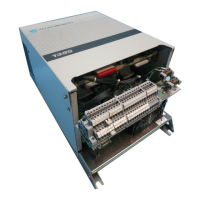3-8 Malfunctions Not Indicated by a Fault
The motor velocity is not
controlled and excessive
velocity occurs.
The motor velocity is excessive and
parameter 106 “Velocity Fdbk” remains
constant or near zero.
• The velocity feedback device is incorrectly selected. Verify that
parameter 621 “Fdbk Device Type” reflects the proper velocity
feedback device being used.
0 = Encoder Feedback Selected
1 = Armature Voltage Feedback Selected
2 = Analog Tachometer Selected
3 = No Feedback Device Selected
• If Encoder Feedback is selected and the device has
malfunctioned, or no device is connected, or the wrong
encoder PPR is entered in Param 609, the motor will
accelerate uncontrollably and fault on VP-10 Feedback Loss.
• If Armature Voltage Feedback is selected, the motor should
only runaway if an internal component malfunctions. The
armature voltage is sensed at the DC contactor connections. It
is then scaled on the Feedback Board and measured on the
Main Control Board.
• If an analog tachometer is selected and the device has
malfunctioned or is not connected, the motor will accelerate
uncontrollably and fault. Also if the scaling is incorrect, or the
analog input signal from the tach is over voltage, the motor will
accelerate uncontrollably.
The motor accelerates uncontrollably
and parameter 106 “Velocity Fdbk” has
the wrong polarity for the direction
commanded.
• The field polarity and the direction information from the
encoder must match for proper control. Forward direction of the
motor is defined as positive armature voltage +A1/-A2 and
phase A must lead phase B of the encoder for CCW rotation as
viewed from the commutator end of the motor. Forward
direction can be defined as CW rotation by switching the
polarity of the field connections and by switching one encoder
signal pair.
• The same holds true for an analog tachometer. The polarity of
the tach signal must match the polarity of the armature voltage.
Forward rotation can be defined as either CW or CCW
depending on the polarity of both signals.
The motor accelerates uncontrollably
with the motor turning in the same
direction as the velocity command.
• Switch the encoder signal pairs or the analog tach polarity.
Then verify that parameter 107 “Position Feedback” counts up
to a higher value as the motor is rotated in the forward
direction.
The motor runs away with the motor
turning in the opposite direction as the
velocity command.
• Verify that parameter 107 “Position Feedback” counts up to a
higher value when the motor is rotated in the forward direction.
If it does, reverse the polarity of the field connections.
The motor turns at the correct
speed, but rotates in the wrong
direction.
Parameter 107 counts down to a lower
value when the motor is rotated in a
forward direction.
• Reverse both the encoder signal pairs/analog tach polarity and
the polarity of the field connections.
Velocity Control Malfunctions
Malfunction Symptom Solution
!
ATTENTION: If no Feedback Device is selected, uncontrollable acceleration of the motor
could occur. This is a potentially dangerous situation because the drive will not trip on a
Feedback Loss fault. Parameter 621 must only be set to (3) when operating the drive as
an external torque regulator in follower type applications.
Aotewell Ltd industry-mall.net

